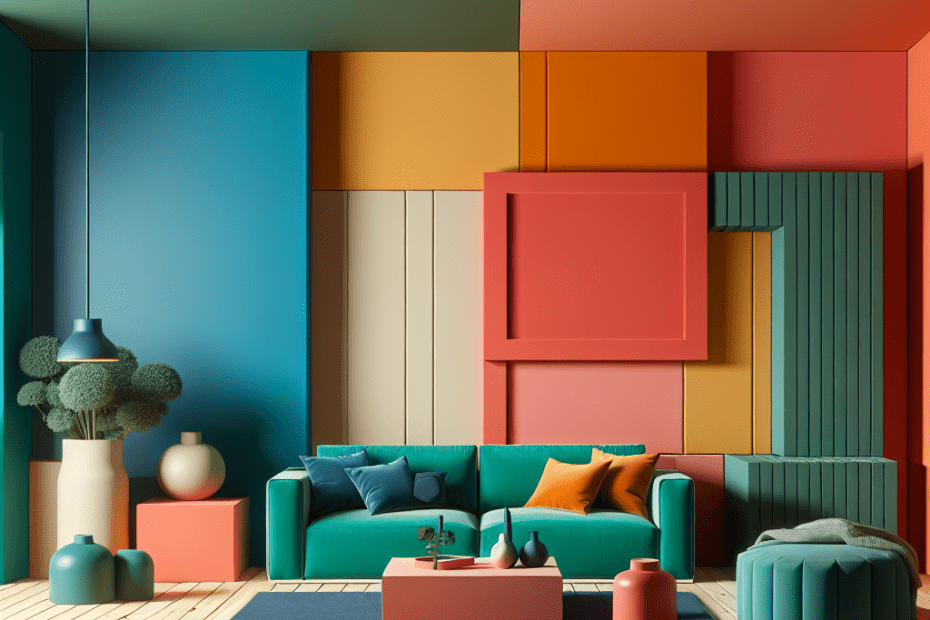“`html
The Bold Impact of Color Blocking in Home Design
Color blocking in design is not just a fashion statement anymore. It has boldly made its mark in the world of home decoration, bringing vibrancy and excitement to interior spaces. More homeowners are embracing this trend for its ability to transform a room’s atmosphere with just a few well-placed blocks of color. Color blocking in design emphasizes the use of contrasting colors to create eye-catching effects that captivate and inspire. But where did this colorful trend originate, and how can it be applied effectively in home decor?
The Origins of Color Blocking in Design
Color blocking initially gained prominence in the 1960s, a decade marked by bold style statements and the rise of popular culture. Designers like Yves Saint Laurent brought it to the runway, igniting an enduring trend that has now transgressed into interior design. Today, color blocking in design is a favored technique among designers who want to add depth, texture, and visual interest to living spaces.
Why They Love Color Blocking
Color blocking is beloved for several reasons. Firstly, it is an excellent way to express personality and taste. With the right hues, they can create spaces that are uniquely theirs. Secondly, color blocking is versatile. It can range from subtle and elegant to daring and audacious, making it suitable for a variety of styles—from modern to eclectic. Thirdly, a well-executed color block can make any room appear more dynamic, cohesively binding together disparate elements within a space.
Statistical Impact
According to a report by Deco Trends, 60% of interior designers stated that they incorporated color blocking techniques in their projects during the past year. Furthermore, 45% of surveyed homeowners felt that the use of color in their homes significantly influenced their mood and productivity, showcasing the psychological impact of colors on daily life.
Applying Color Blocking at Home
When implementing color blocking in design, it’s crucial to start with a plan. They should begin by selecting a primary color that reflects their desired mood or theme. This primary shade can then be paired with complementary or contrasting colors. Here are a few ideas to get started:
- Living Room: Choose a neutral palette and add bold, colorful accents with pillows, an accent wall, or a vibrant sofa.
- Bedroom: Experiment with color-blocked bedding or paint contrasting sections on the walls for a dynamic sleeping space.
- Kitchen: Incorporate colorful cabinetry or a backsplash that contrasts with the countertops and appliances.
The Science Behind Color Choices
Colors influence emotions and perceptions in significant ways. Warm colors such as reds and oranges are said to stimulate conversation and appetite, making them ideal for dining areas. Cool shades like blues and greens provide tranquility and can enhance concentration, well-suited for workspaces or bedrooms. The strategic use of these contrasting colors not only elevates a space’s aesthetic appeal but also harmonizes the occupants’ psychological well-being.
| Color | Impact |
|---|---|
| Red | Energizes and stimulates appetite |
| Blue | Calms and aids concentration |
| Green | Refreshes and balances |
| Yellow | Cheerful and improves mood |
Challenges and Considerations
While color blocking can yield striking results, they must approach the technique strategically. Overdoing it can lead to a cluttered or chaotic room. It’s important to maintain balance and ensure that color blocks enhance rather than overwhelm the space. Additionally, they should consider natural light when choosing colors as it can alter the perception of hues, making them appear different at various times of the day.
Key Takeaways
- Color blocking in design originated in the 1960s and is now popular in home decor.
- It allows homeowners to express their personality and adds depth to interior spaces.
- Correct application requires careful planning and an understanding of color psychology.
- Awareness of lighting and balance is crucial to avoid overwhelming aesthetics.
FAQs
- What is color blocking in design?
Color blocking involves using contrasting blocks of color to create bold, vibrant visual effects in a space. - How does color blocking affect mood?
Different colors impact emotions, with warm colors invigorating and cool tones calming, influencing mood and behavior. - Can color blocking work in small spaces?
Yes, when used thoughtfully, it can make small spaces feel more dynamic without overwhelming them. - What colors work best for a calming environment?
Soothing colors like blues and greens are ideal for creating tranquil, calming environments. - Is color blocking suitable for any interior style?
Color blocking can complement various styles, from contemporary to eclectic, based on the choice of colors and patterns used.
“`
By embracing color blocking in design, they can revitalize their homes with personality and flair. With its impactful use of contrasting colors, this vibrant trend continues to captivate designers and homeowners alike, promising endless opportunities for creative expression.
